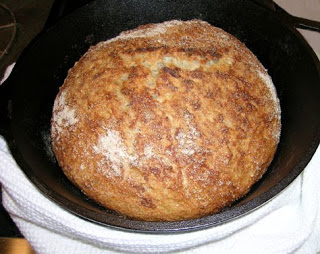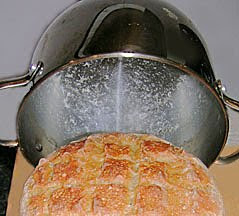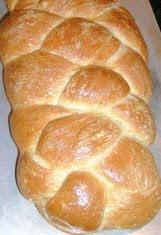In a few days I’ll be heading to Portland, Oregon, for an exciting culinary conference. While I’m there, master baker Peter Reinhart and I will be presenting a workshop on slow-rise and no-knead bread techniques. Attendees will get to watch and also ask all the questions they like. (They’ll also get to try sample breads!)
Some of the questions I know will come up are ones that fans of Kneadlessly Simple have already asked in e-mails to me. I thought you might be interested in the questions and, hopefully, learn from the answers I sent them.
The first two questions below deal with suitable pots for baking breads. I answered a number of “bread pot” questions in two earlier posts, so if the details below don’t cover what you need, check out some basics here and some follow-up info here. Just in case you’re interested, the snapshot on the left shows my garlic parmesan–a very fragrant and tasty loaf! For some good, crusty no-knead bread recipes click here or go to my home page.
Q: I know you have suggested various pots for baking breads before, but you have never mentioned lightwight pots to use. I don’t like heavy pots because they are very hard for me to lift. Can I use lighter ones or will they just not work with your recipes?
A: I was a bit skeptical as to whether lightweight pots, especially stainless steel, would work because this metal doesn’t conduct, hold, or distribute heat nearly as well as cast iron or enamel-coated aluminum or carbon steel. But after testing several sturdy, but still inexpensive and lightweight stainless pots, I can definitely say they will work just fine. (As you can see from the pic, my Kneadessly Simple San Francisco-style sourdough loaf came out very well.) You may need to bake a little longer than the recipe calls for, and will likely not get a deeply browned loaf.
I have found that the doughs tend to stick in stainless pots, so be sure to spritz the interior with non-stick spray just before adding the dough to the pot. Also, be sure to check that the handles and lid of the pot can be heated to 450 degrees. One bargain pot I purchased had a glass lid that was not oven-safe beyond 350 degrees F. (I tested the pot by covering the top with aluminum foil, which worked okay but wasn’t ideal.)
Q: I have the 5-qt cast iron pot, but would actually prefer to also be able to make bread of different shapes. I also have a 9×5 stoneware loaf pan which says it is safe for up to 500 degrees. As I make my way through your book, are your recipes specifically tailored for use with either a closed “steamy” environment like my cast iron pot or my open loaf pan,or can I use the doughs interchangeably? I.e., if I take my dough from the oat bread recipe (loaf recipe), would it work for me to bake it at slightly higher temp (and for shorter time) in an enclosed clay or cast iron pot? Vice versa, if I take dough from a pot recipe, can I also just bake it at lower temp (and for longer) in an open loaf pan?
Also, again with your Oatmeal bread recipe, if I’d like to obtain the crust of the cast iron enclosed pot method but in a log shape, can I just put it into my stoneware loaf pan with a cover (what would you recommend?) and try to recreate the enclosed method?
A: I have found the 5- or 6-quart pots too large–the dough spreads too much, yielding a flat loaf; a 3 1/2 qt pot works much better. (See the links suggested.) I don’t really suggest using stoneware–I’m afraid that the shock of room temperature dough in a really hot pot could cause shattering. Also, the chance of the dough sticking is much greater in stoneware and ceramic pots.
As for the question about baking in a different pot/pan than I call for: Yes, feel free to do this. You will have to experiment with the baking times and temps just as you suggested. If you choose to bake a bread in a covered pot, it is going to have a much harder/crisper crust than otherwise. If a crusty sort of loaf is not baked in a covered pot when that is called for, it’s crust may be less crusty than you want. I’ve heard of some who wanted to bake in loaf pans but wanted crusty tops putting the loaf pans into a covered roaster or large oval Dutch oven to get results similar to baking directly in a covered pot; it will work. BTW, if the loaf comes out with a harder crust than you like, this can always be fixed by draping a clean tea towel over the warm loaf a little while–the trapped moisture will soften the crust a bit. Also it doesn’t work terribly well to cover a loaf pan with foil to trap the steam–the most important changes in the crust come during the first few minutes of baking, but you can’t usually cover the dough in the beginning because it is soft and the foil will stick to it.
Q: My grandson is almost 4 ½ years old, and is allergic to eggs (among other things.) I have been making challah for him, which we eat weekly and he takes to school to participate with the rest of his class. I use an egg replacer (not substitute) which is a powder made of tapioca powder (and other things) combined with water. The basic rule: never replace more than 2 eggs in a recipe, so my challah recipe does work. But it involves mixing, a rise, a shaping and another rise. (my whole Sunday, essentially).
My question: will this egg replacer work for Kneadlessly Simple? It would make my life, of so much simple. Any suggestions? Could I make the dough at night, and then bake it at 4 PM the next day?
A: I don’t see any reason why the KS recipe wouldn’t work–although I’ve learned that the only way to be sure is to actually try something! (The pic shows the recipe made with real eggs, not replacer!) The plan to make the dough at night, then bake the next afternoon seems just fine. If the replacer works in other doughs, I don’t see why it woudn’t work here too. I would just incorporate it in place of the eggs as the recipe directs.




Comments